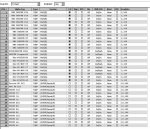I'm not sure I understand. If I want to listen to 3 different control channels on a multi-site system, because they have different talk-groups associated with each site, is there a way to set a scanlist up where the scanner can scan each site?
Well, this operation was no fun. I tried to “start from scratch” with a new, unused V-Scanner Folder. I thought that I was merely repeating operations that were very similar (if not exact) to operations that I had preformed before, and was currently using satisfactorily during my regular scanning.
There would seem little to gain by posting hundreds of words here describing “programming” operations that were not successful. However, the problems seem to occur when I tried to copy the new V-Scanner Folder to the radio. Three times the radio hung with error messages. Each time Windows stepped in and asked if I wanted to repair the drive (answered yes). Each time, I went back to the EZScan Software, to find out that TGID’s had disappeared from their respective Sites (just this V-Scanner Folder, Praise the Lord). When I tried to re-import (DB to EZScan) the TGID’s would not import along with their respective Sites. Three times I went to GRECOM and re-installed the EZScan Program.
Well, I finally gave up, and after some mulling over the situation, I decided to try another method. This method would be much easier, but I don’t know if it would pass the OP’s criteria.
I already was scanning individual Sites in the RWC (Maricopa County, AZ), but they were all in different ScanLists. When I’m stationary, I have only scanned two of these lists. It was a simple matter to put these two Sites (two groups of TGIDs) into a single unused ScanList (I picked #100, and renamed it TriTest). Now, I just needed to add a third Site (and it’s respective TGIDs) to “TriTest.
_______________________________________________________________________________
I need to interject a little Philosophical “rant” into this narrative. I know that there are several “experts” that frequent the Forums that are eager to “explain” to me what I am doing wrong. They are also ready to ask me “Why are you making this so difficult?”, or any of many comments of a similar nature. I also know from experience, that the worst offenders often times do not even own the radio being discussed. Their comments are often predictable, and often appear to be the parroting of conventional wisdom, lol. I, however, prefer to respond/report to a post/question with information that I have actually witnessed, right here in front of my face. Interjection mode off, continue below, from above.
_________________________________________________________________
The way I isolate the Sites is in general as follows:
I import the whole entire RWC/TRS ( I never fool with this TRS, I use it only to make “Duplicates”). Then I immediately “Duplicate” it and give it a new name. Now I can remove/delete unwanted Sites/TGIDs. I was having a problem here with the third Site. I have never actually scanned fully successfully (from my home) a third Site (ScanList for me) that was part of the RWC.
__________________________________________________________________________
More interjection, lol. Just creating something into the EZScan Software is no proof of success. I’m in the Forum minority here. Take this particular problem/challenge we are discussing. I need to not only create in the Software, but to also upload to the radio, and also successfully scan (hear/listen) to three Sites in a single ScanList. Just saying that it can be done, or not done, for me, is not possible. Interjection mode off, continue below, from above.
________________________________________________________________________
Well, the HP (E) came through for me again. I had to analyze combinations of TGIDs and Sites to find a good third candidate for my third entry into the TriTest ScanList. I settled on Peoria PD TGIDs using the White Tank Regional Park (WTRP) Site. I made a another duplicate of the full RWC/TRS, and renamed it (WTRP) Peoria PD. Then I operated on this new Site, paring down the TGID’s to only those of the Peoria
PD and deleting all Sites except the WTRP Site. Then I assigned these TGID’s to the TriTest Scanlist. Then I sent the V-Folder to the scanner, and began scanning.
The two regular sites (A: Phx PD and B: Phx FD) were obviously very active (as usual). Not a peep from Peoria. Next, I locked out the Phx PD and the Phx FD TGIDs, leaving only the Peoria PD TGIDs open. After a while, I got a hit, then a few more, and while I am typing this report, more active yet. I imagine, about 1:00 A.M., things will get hopping in Peoria too, lol.
I have attached a screen shot of what the “TriTest” ScanList looks like. It is easy to see the three “divisions”. They have different names under “System”. They are actually all part of the RWC/TRS System, but the Software and the radio don’t know that, lol. You will have to trust me that the three “divisions” are using different Sites, respectively. Also, ScanList 2, 3, and 10, are locked out. Looking at the radio, I see only TriTest and a ROCK SOLID rarely flickering “T” (except when I hear voices, lol).
I am not sure if this result complies with your “criteria”, but regardless, this report might be found to be amusing by some, lol.
http://forums.radioreference.com/images/attach/jpg.gif
Thanks,
Rob


